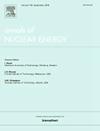Study on liquid phase separation phenomenon by constructing multi-physics field model
IF 1.9
3区 工程技术
Q1 NUCLEAR SCIENCE & TECHNOLOGY
引用次数: 0
Abstract
After the core meltdown in a severe accident, the molten pool (corium) formed at the lower head of the pressure vessel occurs liquid phase separation phenomenon at high temperature, Corium’s morphologic evolution has a great influence on theIn-vessel retention technology. Therefore, the purpose of this study is to investigate the transient morphological evolution of the molten pool by coupling the thermodynamic properties of the corium, the flow and heat transfer characteristics. Firstly, considering the solidification effect, a multi-physics model with phase field − flow field − temperature field coupling is constructed to simulate the dynamic liquid phase separation phenomenon of the corium. Then it is verified that the phase-field model can be applied to macroscale simulation by using the U-O binary free energy for practical purposes. Also the morphological evolution and its kinetics of the U-O binary system, as well as the formation mechanism are discussed. The transient process of droplets nucleation, floating, fusion, and finally formation of stratified structure was observed, and the phenomenon of a ring of solid oxide wrapped around the liquid-phases was found. The results show that the constructed model can clearly capture the dynamic phenomenon in the process of liquid phase separation, and the model can be applied to the analysis of liquid phase separation of quaternary or multivariate systems, so as to provide a certain support for the safety analysis and design of reactors. It can also provide a reference for the analysis of liquid phase separation of complex materials.
求助全文
约1分钟内获得全文
求助全文
来源期刊

Annals of Nuclear Energy
工程技术-核科学技术
CiteScore
4.30
自引率
21.10%
发文量
632
审稿时长
7.3 months
期刊介绍:
Annals of Nuclear Energy provides an international medium for the communication of original research, ideas and developments in all areas of the field of nuclear energy science and technology. Its scope embraces nuclear fuel reserves, fuel cycles and cost, materials, processing, system and component technology (fission only), design and optimization, direct conversion of nuclear energy sources, environmental control, reactor physics, heat transfer and fluid dynamics, structural analysis, fuel management, future developments, nuclear fuel and safety, nuclear aerosol, neutron physics, computer technology (both software and hardware), risk assessment, radioactive waste disposal and reactor thermal hydraulics. Papers submitted to Annals need to demonstrate a clear link to nuclear power generation/nuclear engineering. Papers which deal with pure nuclear physics, pure health physics, imaging, or attenuation and shielding properties of concretes and various geological materials are not within the scope of the journal. Also, papers that deal with policy or economics are not within the scope of the journal.
 求助内容:
求助内容: 应助结果提醒方式:
应助结果提醒方式:


